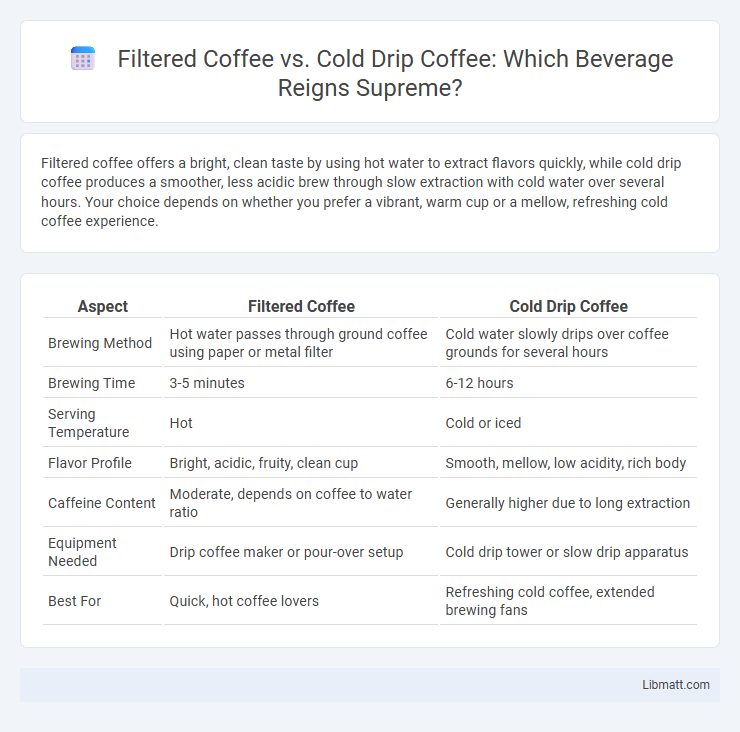Filtered coffee offers a bright, clean taste by using hot water to extract flavors quickly, while cold drip coffee produces a smoother, less acidic brew through slow extraction with cold water over several hours. Your choice depends on whether you prefer a vibrant, warm cup or a mellow, refreshing cold coffee experience.
Table of Comparison
| Aspect | Filtered Coffee | Cold Drip Coffee |
|---|---|---|
| Brewing Method | Hot water passes through ground coffee using paper or metal filter | Cold water slowly drips over coffee grounds for several hours |
| Brewing Time | 3-5 minutes | 6-12 hours |
| Serving Temperature | Hot | Cold or iced |
| Flavor Profile | Bright, acidic, fruity, clean cup | Smooth, mellow, low acidity, rich body |
| Caffeine Content | Moderate, depends on coffee to water ratio | Generally higher due to long extraction |
| Equipment Needed | Drip coffee maker or pour-over setup | Cold drip tower or slow drip apparatus |
| Best For | Quick, hot coffee lovers | Refreshing cold coffee, extended brewing fans |
Introduction to Filtered Coffee and Cold Drip Coffee
Filtered coffee, brewed by pouring hot water over ground coffee beans using paper or metal filters, offers a bright, clean flavor profile with distinct aromatic notes. Cold drip coffee, also known as Dutch coffee, involves slowly dripping cold water through coffee grounds over several hours, resulting in a smooth, less acidic beverage with rich, concentrated flavors. Both brewing methods emphasize clarity and extraction control but differ significantly in temperature and extraction time, impacting taste and caffeine content.
Brewing Techniques: Filtered vs Cold Drip
Filtered coffee uses hot water poured over ground coffee in a paper or metal filter, extracting flavors quickly through immersion and percolation. Cold drip coffee slowly draws cold water through coffee grounds over several hours, resulting in a smoother, less acidic brew with distinct flavor nuances. Your choice between these brewing techniques affects the extraction time, temperature, and ultimately the taste profile of your coffee.
Flavor Profiles Compared
Filtered coffee delivers a clean, bright flavor with pronounced acidity and nuanced fruity or floral notes, stemming from the hot water extraction process that highlights coffee's aromatic compounds. Cold drip coffee offers a smoother, less acidic profile with rich, sweet undertones and a heavier mouthfeel, as the slow, cold extraction minimizes bitterness and preserves natural sugars. Both brewing methods emphasize unique flavor dimensions, with filtered coffee showcasing brightness and clarity while cold drip emphasizes depth and subtle sweetness.
Caffeine Content Differences
Filtered coffee typically contains more caffeine than cold drip coffee due to the higher brewing temperature and shorter extraction time, which enhances caffeine solubility. Cold drip coffee, brewed slowly with cold water over several hours, results in lower caffeine extraction but offers a smoother, less acidic flavor profile. Your choice depends on whether you prioritize a stronger caffeine kick or a milder, more refreshing coffee experience.
Equipment Needed for Each Method
Filtered coffee requires a drip coffee maker or manual pour-over equipment like a cone-shaped filter, a filter paper or metal filter, and a hot water source to pour over the grounds. Cold drip coffee needs a specialized cold drip tower or cold brew coffee maker with a slow drip mechanism, a water chamber, a bed of coffee grounds, and a collection vessel for the brewed coffee. Both methods depend on precise control of water flow, but cold drip coffee equipment typically demands longer setup and brewing times compared to the quicker, simpler filtered coffee apparatus.
Brewing Time and Process
Filtered coffee typically brews in 3 to 5 minutes using hot water that passes quickly through the grounds, extracting bright and balanced flavors. Cold drip coffee involves a slow brewing process lasting 6 to 12 hours, where cold water gradually filters through the grounds, resulting in a smooth, less acidic concentrate. Your choice between these methods will influence both the flavor profile and the time investment required for brewing.
Temperature Effects on Extraction
Temperature plays a crucial role in coffee extraction, with filtered coffee typically brewed at 195-205degF, promoting faster solubility and yielding a brighter, more acidic flavor profile. Cold drip coffee uses near room temperature or cooler water over an extended period, producing lower acidity and smoother, sweeter notes due to reduced extraction of bitter compounds. The lower temperatures in cold drip methods emphasize delicate aromas and subtle flavors, contrasting the bold, robust characteristics extracted in hot filtered brewing.
Health Benefits and Nutritional Aspects
Filtered coffee retains essential antioxidants and vitamins like niacin and magnesium, supporting heart health and metabolism. Cold drip coffee, brewed slowly over hours at low temperatures, often contains lower acidity and can reduce stomach irritation while preserving chlorogenic acids linked to anti-inflammatory effects. Both methods offer hydration and antioxidants, but filtered coffee typically provides higher caffeine content and a broader spectrum of nutrients.
Cost and Accessibility of Each Method
Filtered coffee requires standard equipment like a drip coffee maker or pour-over setup, which is generally affordable and widely available, making it accessible for most households. Cold drip coffee involves specialized slow-drip towers or cold brew devices that tend to be more expensive and less common, often requiring a longer brewing time and more counter space. The initial investment and preparation time for cold drip coffee can limit its accessibility compared to the more cost-effective and quicker filtered coffee method.
Which Coffee Style Suits You?
Filtered coffee offers a bright, clean flavor with a smooth body, ideal for those who enjoy a balanced and aromatic cup brewed quickly. Cold drip coffee provides a rich, mellow taste with low acidity and a thicker mouthfeel, perfect for coffee lovers seeking a refreshing and less bitter experience. Your choice depends on whether you prefer a hot, vibrant brew or a cool, concentrated coffee with subtle sweetness.
Filtered coffee vs cold drip coffee Infographic

 libmatt.com
libmatt.com